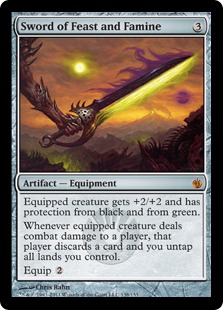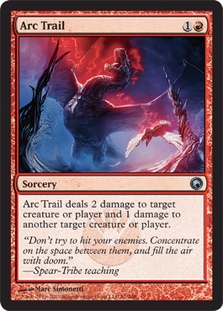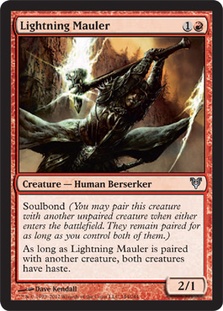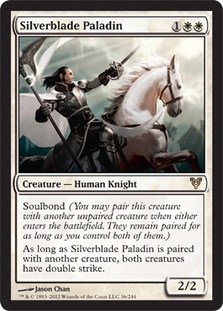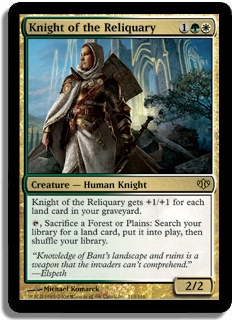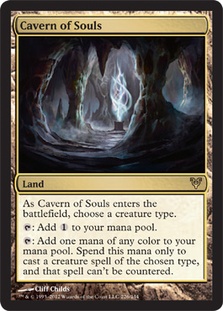When people think about the best races in Magic, they tend to think of Goblins, Elves, Merfolk, Faeries, and Vampires most of the time. This is partly because these races have fancy Lords that showcase their combined synergistic energy. Growing up with the game, I was fascinated with Elvish Champion and Goblin King. These cards were the nut high for me, and I always wanted to jam four of them in every deck I built. The other reason players think of these races first is the obvious tribal synergies they have with each other: Goblin Lackey lets you put a Goblin from your hand into play, Wellwisher gains you one life for each Elf in play, Mistbind Clique requires a Faerie to be championed, etc. They promote synergy, and the more creatures of a given race you have on the battlefield, the better.
‘More’ doesn’t necessarily translate into ‘better’ anymore. I daresay Humanity carries the flag for the most powerful race in Magic today! Magic follows sci-fi and fantasy lore to a T! Mass Effect fans know only humanity can stop the Reapers. Lord of the Rings fans know that Lord Elrond puts his trust in humanity. However, humanity tends to be a solo act, and we are not team players. Humans are some of the best aggressively costed creatures in Magic. They work well together because of their raw power, not because of their synergistic value.
It’s not hard to argue that some of the best creatures in the game benefit from having Human as their race.
Here are a few that come to mind:
- Dark Confidant
- Delver of Secrets
- Snapcaster Mage
- Mother of Runes
- Noble Hierarch
- Knight of the Reliquary
- Mirran Crusader
- Huntmaster of the Fells
- Hero of Bladehold
- Thalia, Guardian of Thraben
These are the tip of the iceberg. It’s no question that Humanity packs an impressive punch. This leads to the reason why lately I’ve been bringing Humans together to the Promised Land called Cavern of Souls.
This is the Standard deck I have been working with:
Creatures (27)
- 4 Birds of Paradise
- 3 Hero of Bladehold
- 4 Blade Splicer
- 2 Fiend Hunter
- 4 Avacyn's Pilgrim
- 2 Daybreak Ranger
- 4 Huntmaster of the Fells
- 4 Restoration Angel
Lands (24)
Spells (9)

I played this deck to a 7-2-1 record at the SCG Standard Open in St. Louis. I ended up beating three Mono-Green variants, two G/R decks, and two Delver decks while losing to Naya Pod and a different Mono-Green deck. Naya Aggro is a very strong choice and is well positioned in the current metagame.
Overall, I was pleased with the version of the deck I played. A couple of cards that really stood out to me as game changers were Sword of Feast and Famine and Arc Trail.
Sword of Feast and Famine truly gave me the advantage I needed against the field of green dinosaurs. Cards like Dungrove Elder and armies of Elves fill a lot of local metagames, so Sword of Feast and Famine was seldom a card I didn’t want to draw.
Arc Trail was one of the best cards in my deck partly because in game 1s it was almost always a two-for-one, hitting opposing Delvers and Snapcaster Mages and giving me the edge in certain ramp matches. Killing an opponent’s mana dorks early on is oftentimes the difference between winning and losing and is the key to success especially when opposing strategies go bigger than you. I found Arc Trail gave me the time I needed to get set up for Hero of Bladehold or Huntmaster of the Fells.
Cloudshift was a nice surprise card that is not played around that gave some great Blade Splicer blocks but was often sided out for key cards game 2 and 3. I do enjoy what Cloudshift brings to the table, and when not expected it makes for some favorable blocking situations and defensive opportunities for crucial creatures like Hero of Bladehold.
I feel keeping to the Human theme has been great for me lately since it’s given me full value out of Cavern of Souls. But it’s really about how you want to approach the environment since Standard is still very wide open in my opinion. Delver has continued to be really popular for me locally, so that’s usually what I prepare my deck to play against.
A few cards I have been adding in and out are Lighting Mauler and Silverblade Paladin. I have lived the dream a few matches by playing my Hero of Bladehold with a Lighting Mauler out on the field to give my turn 3 Hero haste. I have to say that I haven’t lost very many of those games. Silverblade Paladin has also been a great way to improve my clock, and it’s always nice to be able to catch opponents off guard by Blinking it and switching double strike targets on the fly.
Oblivion Ring and Thragtusk have been in and out of the maindeck as well. Oblivion Ring is just one of the cards that I feel you get better value out of in game 1 than you do games 2 and 3 because your opponents are less prepared for it. Thragtusk is a beast of a finisher and works well with the overall vibe of the deck, especially since when he Blinks away you get a 3/3 Beast along with gaining more life. Five mana does feel like a rather large commitment to me at times, and I don’t always have the luxury of ramping into him. I have been working him in over the Fiend Hunter sometimes.
There are definitely no exact answers to break Standard at the moment, and as the Standard metagame comes into its own, don’t be afraid to consider all of your options when you sleeve up your 75 at your next event.
In Legacy, I have been playing the following:
Creatures (24)
- 4 Mother of Runes
- 4 Dark Confidant
- 4 Noble Hierarch
- 4 Knight of the Reliquary
- 4 Stoneforge Mystic
- 2 Mirran Crusader
- 2 Thalia, Guardian of Thraben
Lands (22)
Spells (14)

This deck takes a lot of the best Humans in the game and puts them together to make one devastating combination. I really do believe Cavern of Souls in the right deck is a better Aether Vial because it doesn’t need additional turns to give you value. Right from the start Noble Hierarch can escalate your board presence or Mother of Runes can protect Dark Confidant to allow him to take over the game with card advantage.
Knight of the Reliquary plays a heavy disruption role, fetching up Wastelands or getting another Cavern of Souls so Kor can be named and Stoneforge Mystic’s resolution guaranteed. The deck curves out very nicely and has good, consistent draws because it’s packed with so much good stuff. The Stoneforge package adds an additional dimension to the deck since most of the creatures are great equipment carriers. Stoneforge isn’t the lifeblood of the deck, so even if the equipment is dealt with your team is formidable regardless.
The deck has a fairly good matchup against all the fair decks in the format, and against the combo decks it has the ability to win games with quality disruption sideboarded in.
This deck also has access to some great sideboard options. I have been switching a few cards in and out depending on the expected metagame. The deck has the ability to turn into a hate bear deck if need be, which is wonderful in certain combo matchups.
Being green, black, and white gives some wonderful sideboard options. Here are few cards to consider for the sideboard depending on the metagame you anticipate your upcoming tournament to have:
Engineered Plague – Elves is played more often than not, and it has applications against Goblins and other tribal decks as well.
Choke – Merfolk can play through this with ease, but some of the Esper and Stoneblade decks don’t do well when this is resolved.
Extirpate / Surgical Extraction – Reanimator is still a powerhouse, and Griselbrand makes a great target!
Yixlid Jailer – This guy plus an active Mother of Runes makes it pretty difficult for Dredge to win.
Ethersworn Canonist and Gaddock Teeg – Some much needed hate bears to buy you the time you need against those pesky combo decks.
Path to Exile – More removal is needed at times, and you get full value out of Path against RUG Delver decks. Â
Life in the world of Humans is looking pretty good. I am enjoying both formats with Humanity at my command! Feel free to share any results you may have or any different builds you have been working on.
Thanks for reading!

